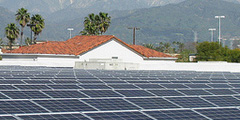The debate over net metered solar is getting louder and more spirited, as utilities resist efforts to remove caps on how much energy solar customers can return to their grid. New reports, like the one released below by the Interstate Renewable Energy Council, advocate for those caps to be removed. We’re watching this issue carefully and will continue to post relevant opinions here. Read the original Rewire Utilities article here.
California leads the nation in distributed solar power generation (DG), but if the state wants to keep its rooftop and community solar lead it’s going to have to get rid of limits on “net-metered” solar power. That’s according to a new report released February 21 by the Interstate Renewable Energy Council (IREC).
 According to the report, “Blueprint for the Development of Distributed Generation in California,” the state also needs to promote community distributed solar projects for people without access to a suitably sunny rooftop, and make other policy changes to help roll out distributed generation capacity more effectively.
According to the report, “Blueprint for the Development of Distributed Generation in California,” the state also needs to promote community distributed solar projects for people without access to a suitably sunny rooftop, and make other policy changes to help roll out distributed generation capacity more effectively.
Net metering is the term used to describe arrangements by which property owners feed power from their own solar arrays back into the grid through their electric meter, running it backward toward zero. California currently limits net-metered energy from rooftop and similar solar arrays to five percent of peak customer demand; this artificial cap, say the authors of the IREC report, will be filled statewide very shortly, reducing the incentive for distributed solar development.
It’s a little odd that utilities would fight raising a net metering cap, as net-metered solar is an astonishingly good deal for them: once a ratepayer’s electric meter rolls back to zero, any additional power fed into the grid is essentially donated to the utility. Contrast this with a feed-in tariff program such as the one being launched by Los Angeles Department of Water and Power: feed-in tariffs pay a set rate per kilowatt hour regardless of the producers’ net energy consumption. Despite the sweetheart deal net-metering offers utilities, they’ve been reluctant to encourage it, arguing with the California Public Utilities Commission (CPUC) over the agency’s interpretation of what constitutes five percent of peak demand, for instance. Utilities have also tried to slap “grid access” surcharges on their net-metering clients.
The IREC report recommends California’s cap on net metering be removed entirely.
The report also recommends that the state implement a “community solar” program to encourage access to solar power for people without suitable roof space of their own, streamline permitting statewide for rooftop and ground-mounted solar, and assess the state’s grid to promote distributed generation in places where it does the most good, especially where it would reduce the need for new transmission lines.
“The recommendations include suggestions regarding procurement, interconnection, system planning and permitting,” says Sky Stanfield, attorney with Keyes, Fox and Wiedman LLP, which represents IREC. “Achieving the greatest benefits from DG will require strategic action in all of these areas, and IREC’s blueprint helps to identify the ways in which they interrelate.”










